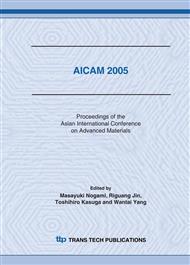p.713
p.717
p.721
p.725
p.729
p.733
p.737
p.741
p.745
Filler Network Change and Nonlinear Viscoelasticity of Rubbers
Abstract:
Uncured, filled rubbers show remarkable nonlinear viscoelasticity as well as cured, filled rubbers. The nonlinearity may come from change in entanglement and filler network structures. Many people use dynamic modulus to characterize rubber materials. However, dynamic modulus cannot be defined at large strain. Hence we must study a viscoelastic function to be defined at large strain. In addition, we need other information to separate the effects of the change in entanglement and filler network structures on nonlinear viscoelasticity. In this work, we have measured simultaneously relaxation modulus G(γ,t) and electrical resistivity ρ(γ,t) for carbon black (CB)-filled, uncured styrene-butadiene copolymers (SBRs) at wide range of strains. Electrical resistivity at equilibrium, ρ(0,t), showed step-like change at the CB loading between 20 and 35 phr, indicating threshold for filler network formation should exist in the range of values in CB loading. Both G(γ,t) and ρ(γ,t) for the samples having CB loading to be higher than the threshold showed nonlinearity at the strain larger than shear strain γ=0.1, indicating rupture in filler network at large strain.
Info:
Periodical:
Pages:
729-732
Citation:
Online since:
February 2006
Authors:
Price:
Сopyright:
© 2006 Trans Tech Publications Ltd. All Rights Reserved
Share:
Citation:


